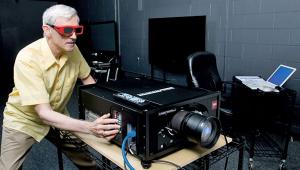Dual-Projector 3D at Home

Walter starts by stating the advantages of dual projectors for 3D—double the brightness, the ability to use standard 60Hz projectors, and redundancy for 2D applications (that is, you can still watch 2D if one projector fails for some reason). But then he goes on to elucidate four reasons to avoid this approach.
Convergence The two projectors must be perfectly converged on the screen, which is nearly impossible, especially the corners of the image.
Lens Shift Neither projector can be placed in its optimum position relative to the screen, so both must use lens shift to converge the two images. The best-case scenario is placing one projector relatively low with an upward lens shift and the other near the top of the screen with a downward lens shift, but this makes it difficult to keep the light from hitting the backs of chairs or audience members' heads.
HDMI A dual-projector 3D system requires that the 3D HDMI signal be processed to separate the left and right portions. Walter claims there are no retail processors that can do this, and I don't know of any, either.
Cost Aside from the obvious fact that two projectors generally cost more than one, there are the lamps, which must be replaced regularly at twice the cost of a single-lamp system. Also, the lamps must be monitored to make sure their brightness remains balanced.

I can't really argue with Walter on any of these points, but that doesn't mean dual-projector 3D is necessarily unworkable. At least two companies are taking this approach—SIM2 with two of its C3X Lumis projectors in a specially designed frame (seen at the top of this blog) and Runco with its D-73d (seen above), which combines two projection engines in one chassis.
To solve the convergence problem, the SIM2 frame includes ultra-precise mechanical alignment controls for one the projectors as well as lens shift and zoom in each one. The Runco D-73d provides lens shift and zoom for each engine as well as a warping function that brings the final image into alignment within one pixel; ideally, only one of the images would be warped to minimize scaling artifacts. Both systems must be placed relatively low, so seating in front of them is limited as Walter points out.
As for the HDMI problem, SIM2 provides a 1-in/2-out HDMI splitter, which sends the same signal to both projectors. Each projector then uses proprietary internal processing to remove the left or right information depending on which one it's assigned to display. With the Runco system, HDMI from the source enters a custom-designed 3Dimension processor, which separates the left and right images and sends them via two HDMI cables to two DHD4 outboard video processors and then on to the projection engines.
Of course, both the SIM2 and Runco systems are expensive—$80,000 and $50,000, respectively, without anamorphic lenses—and the lamp monitoring and replacement costs add up quickly for the SIM2, but not for the Runco, which uses LED illumination. (There's a trade-off here—LEDs require no monitoring or replacement, but they generally produce less light than conventional lamps.) In any event, for the very rich, hiring someone to set up and maintain a dual-projector system might well be worth it for a brighter picture, which 3D really needs to look its best.
- Log in or register to post comments





















































